Christiana Care Code Blue Simulation: Media Annotation and Analysis
VerifiedAdded on 2023/01/03
|11
|2917
|2
Report
AI Summary
This report presents a media annotation of a Christiana Care Code Blue simulation video, analyzing the performance of healthcare professionals during a simulated cardiac arrest scenario. The analysis evaluates adherence to ARC guidelines, identifies strengths such as leadership and prompt response, and highlights weaknesses including inadequate CPR compression depth, lack of pulse checks, and deviations from recommended ventilation rates and defibrillation practices. The report references relevant research to support the assessment and concludes with recommendations for practice changes, emphasizing the need for improved CPR techniques, pulse monitoring, and adherence to established protocols. The analysis underscores the importance of effective training and adherence to best practices in emergency medical care.

MEDIA ANNOTATION
Paraphrase This Document
Need a fresh take? Get an instant paraphrase of this document with our AI Paraphraser
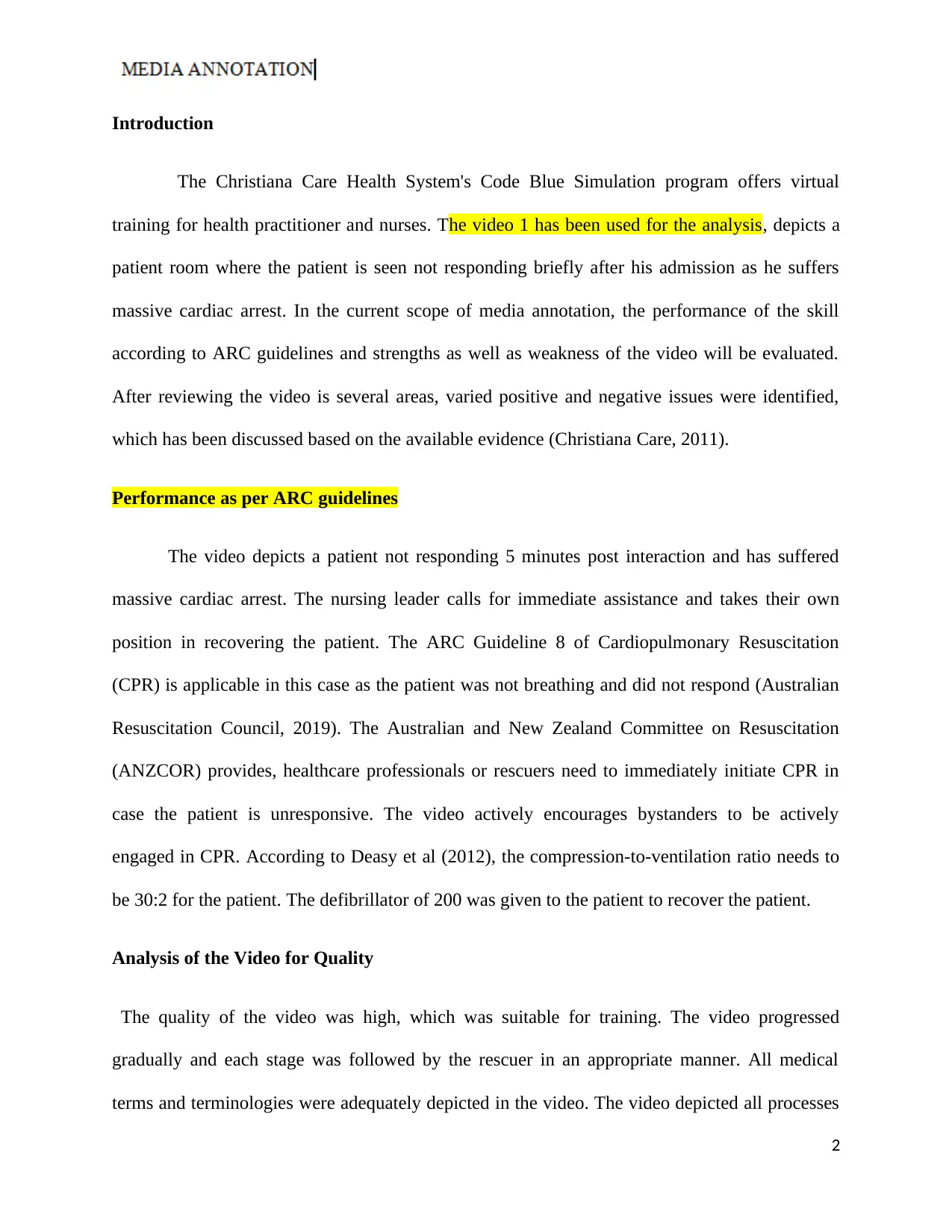
Introduction
The Christiana Care Health System's Code Blue Simulation program offers virtual
training for health practitioner and nurses. The video 1 has been used for the analysis, depicts a
patient room where the patient is seen not responding briefly after his admission as he suffers
massive cardiac arrest. In the current scope of media annotation, the performance of the skill
according to ARC guidelines and strengths as well as weakness of the video will be evaluated.
After reviewing the video is several areas, varied positive and negative issues were identified,
which has been discussed based on the available evidence (Christiana Care, 2011).
Performance as per ARC guidelines
The video depicts a patient not responding 5 minutes post interaction and has suffered
massive cardiac arrest. The nursing leader calls for immediate assistance and takes their own
position in recovering the patient. The ARC Guideline 8 of Cardiopulmonary Resuscitation
(CPR) is applicable in this case as the patient was not breathing and did not respond (Australian
Resuscitation Council, 2019). The Australian and New Zealand Committee on Resuscitation
(ANZCOR) provides, healthcare professionals or rescuers need to immediately initiate CPR in
case the patient is unresponsive. The video actively encourages bystanders to be actively
engaged in CPR. According to Deasy et al (2012), the compression-to-ventilation ratio needs to
be 30:2 for the patient. The defibrillator of 200 was given to the patient to recover the patient.
Analysis of the Video for Quality
The quality of the video was high, which was suitable for training. The video progressed
gradually and each stage was followed by the rescuer in an appropriate manner. All medical
terms and terminologies were adequately depicted in the video. The video depicted all processes
2
The Christiana Care Health System's Code Blue Simulation program offers virtual
training for health practitioner and nurses. The video 1 has been used for the analysis, depicts a
patient room where the patient is seen not responding briefly after his admission as he suffers
massive cardiac arrest. In the current scope of media annotation, the performance of the skill
according to ARC guidelines and strengths as well as weakness of the video will be evaluated.
After reviewing the video is several areas, varied positive and negative issues were identified,
which has been discussed based on the available evidence (Christiana Care, 2011).
Performance as per ARC guidelines
The video depicts a patient not responding 5 minutes post interaction and has suffered
massive cardiac arrest. The nursing leader calls for immediate assistance and takes their own
position in recovering the patient. The ARC Guideline 8 of Cardiopulmonary Resuscitation
(CPR) is applicable in this case as the patient was not breathing and did not respond (Australian
Resuscitation Council, 2019). The Australian and New Zealand Committee on Resuscitation
(ANZCOR) provides, healthcare professionals or rescuers need to immediately initiate CPR in
case the patient is unresponsive. The video actively encourages bystanders to be actively
engaged in CPR. According to Deasy et al (2012), the compression-to-ventilation ratio needs to
be 30:2 for the patient. The defibrillator of 200 was given to the patient to recover the patient.
Analysis of the Video for Quality
The quality of the video was high, which was suitable for training. The video progressed
gradually and each stage was followed by the rescuer in an appropriate manner. All medical
terms and terminologies were adequately depicted in the video. The video depicted all processes
2
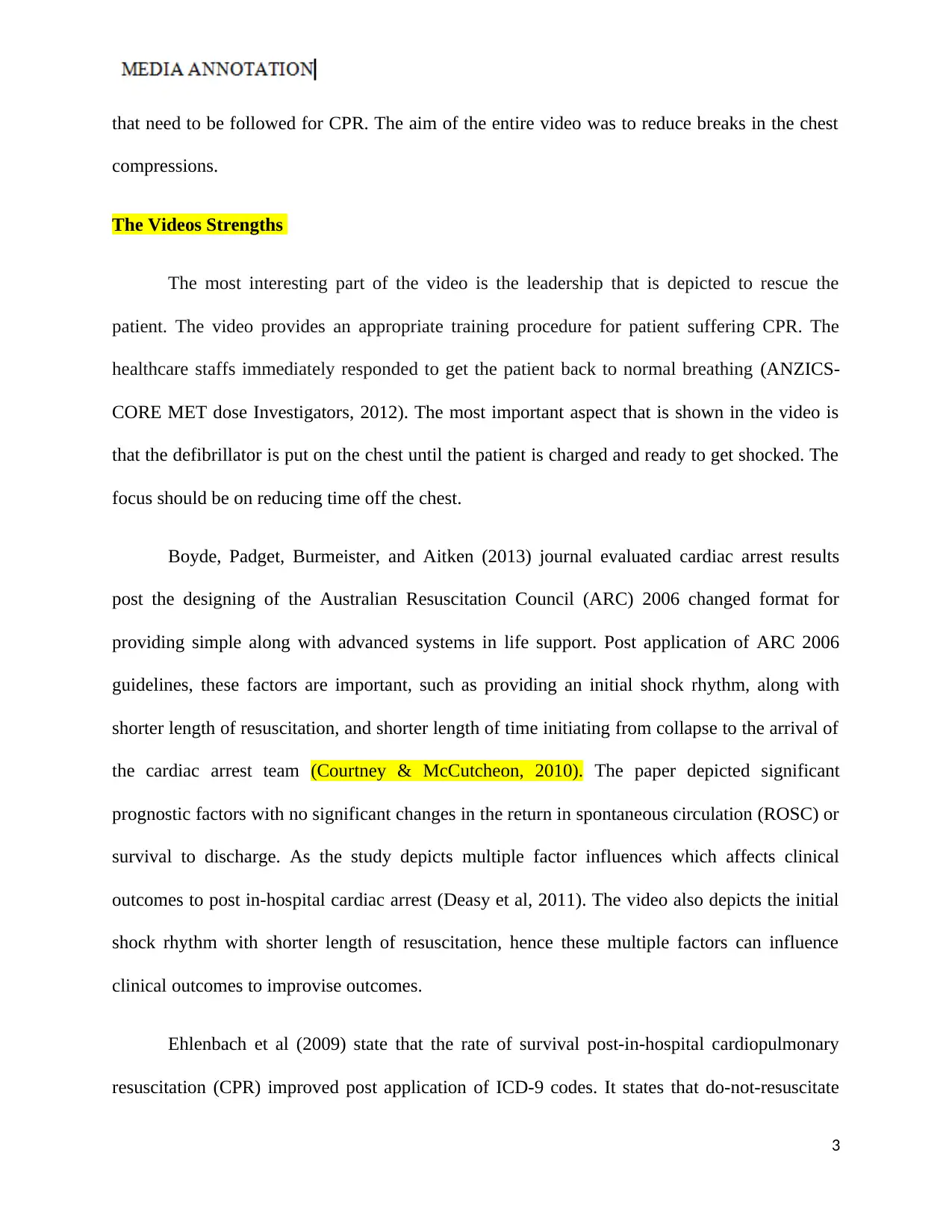
that need to be followed for CPR. The aim of the entire video was to reduce breaks in the chest
compressions.
The Videos Strengths
The most interesting part of the video is the leadership that is depicted to rescue the
patient. The video provides an appropriate training procedure for patient suffering CPR. The
healthcare staffs immediately responded to get the patient back to normal breathing (ANZICS-
CORE MET dose Investigators, 2012). The most important aspect that is shown in the video is
that the defibrillator is put on the chest until the patient is charged and ready to get shocked. The
focus should be on reducing time off the chest.
Boyde, Padget, Burmeister, and Aitken (2013) journal evaluated cardiac arrest results
post the designing of the Australian Resuscitation Council (ARC) 2006 changed format for
providing simple along with advanced systems in life support. Post application of ARC 2006
guidelines, these factors are important, such as providing an initial shock rhythm, along with
shorter length of resuscitation, and shorter length of time initiating from collapse to the arrival of
the cardiac arrest team (Courtney & McCutcheon, 2010). The paper depicted significant
prognostic factors with no significant changes in the return in spontaneous circulation (ROSC) or
survival to discharge. As the study depicts multiple factor influences which affects clinical
outcomes to post in-hospital cardiac arrest (Deasy et al, 2011). The video also depicts the initial
shock rhythm with shorter length of resuscitation, hence these multiple factors can influence
clinical outcomes to improvise outcomes.
Ehlenbach et al (2009) state that the rate of survival post-in-hospital cardiopulmonary
resuscitation (CPR) improved post application of ICD-9 codes. It states that do-not-resuscitate
3
compressions.
The Videos Strengths
The most interesting part of the video is the leadership that is depicted to rescue the
patient. The video provides an appropriate training procedure for patient suffering CPR. The
healthcare staffs immediately responded to get the patient back to normal breathing (ANZICS-
CORE MET dose Investigators, 2012). The most important aspect that is shown in the video is
that the defibrillator is put on the chest until the patient is charged and ready to get shocked. The
focus should be on reducing time off the chest.
Boyde, Padget, Burmeister, and Aitken (2013) journal evaluated cardiac arrest results
post the designing of the Australian Resuscitation Council (ARC) 2006 changed format for
providing simple along with advanced systems in life support. Post application of ARC 2006
guidelines, these factors are important, such as providing an initial shock rhythm, along with
shorter length of resuscitation, and shorter length of time initiating from collapse to the arrival of
the cardiac arrest team (Courtney & McCutcheon, 2010). The paper depicted significant
prognostic factors with no significant changes in the return in spontaneous circulation (ROSC) or
survival to discharge. As the study depicts multiple factor influences which affects clinical
outcomes to post in-hospital cardiac arrest (Deasy et al, 2011). The video also depicts the initial
shock rhythm with shorter length of resuscitation, hence these multiple factors can influence
clinical outcomes to improvise outcomes.
Ehlenbach et al (2009) state that the rate of survival post-in-hospital cardiopulmonary
resuscitation (CPR) improved post application of ICD-9 codes. It states that do-not-resuscitate
3
⊘ This is a preview!⊘
Do you want full access?
Subscribe today to unlock all pages.

Trusted by 1+ million students worldwide
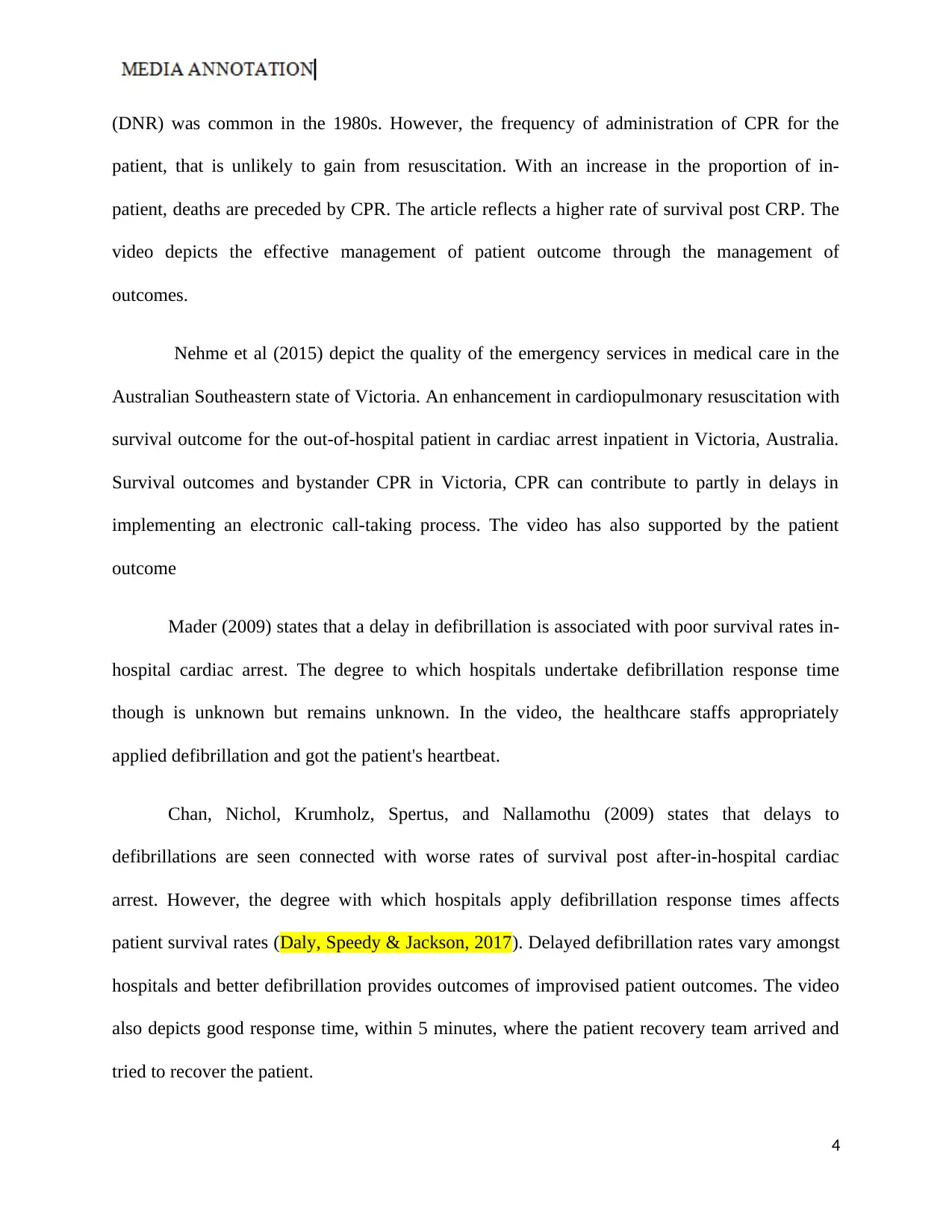
(DNR) was common in the 1980s. However, the frequency of administration of CPR for the
patient, that is unlikely to gain from resuscitation. With an increase in the proportion of in-
patient, deaths are preceded by CPR. The article reflects a higher rate of survival post CRP. The
video depicts the effective management of patient outcome through the management of
outcomes.
Nehme et al (2015) depict the quality of the emergency services in medical care in the
Australian Southeastern state of Victoria. An enhancement in cardiopulmonary resuscitation with
survival outcome for the out-of-hospital patient in cardiac arrest inpatient in Victoria, Australia.
Survival outcomes and bystander CPR in Victoria, CPR can contribute to partly in delays in
implementing an electronic call-taking process. The video has also supported by the patient
outcome
Mader (2009) states that a delay in defibrillation is associated with poor survival rates in-
hospital cardiac arrest. The degree to which hospitals undertake defibrillation response time
though is unknown but remains unknown. In the video, the healthcare staffs appropriately
applied defibrillation and got the patient's heartbeat.
Chan, Nichol, Krumholz, Spertus, and Nallamothu (2009) states that delays to
defibrillations are seen connected with worse rates of survival post after-in-hospital cardiac
arrest. However, the degree with which hospitals apply defibrillation response times affects
patient survival rates (Daly, Speedy & Jackson, 2017). Delayed defibrillation rates vary amongst
hospitals and better defibrillation provides outcomes of improvised patient outcomes. The video
also depicts good response time, within 5 minutes, where the patient recovery team arrived and
tried to recover the patient.
4
patient, that is unlikely to gain from resuscitation. With an increase in the proportion of in-
patient, deaths are preceded by CPR. The article reflects a higher rate of survival post CRP. The
video depicts the effective management of patient outcome through the management of
outcomes.
Nehme et al (2015) depict the quality of the emergency services in medical care in the
Australian Southeastern state of Victoria. An enhancement in cardiopulmonary resuscitation with
survival outcome for the out-of-hospital patient in cardiac arrest inpatient in Victoria, Australia.
Survival outcomes and bystander CPR in Victoria, CPR can contribute to partly in delays in
implementing an electronic call-taking process. The video has also supported by the patient
outcome
Mader (2009) states that a delay in defibrillation is associated with poor survival rates in-
hospital cardiac arrest. The degree to which hospitals undertake defibrillation response time
though is unknown but remains unknown. In the video, the healthcare staffs appropriately
applied defibrillation and got the patient's heartbeat.
Chan, Nichol, Krumholz, Spertus, and Nallamothu (2009) states that delays to
defibrillations are seen connected with worse rates of survival post after-in-hospital cardiac
arrest. However, the degree with which hospitals apply defibrillation response times affects
patient survival rates (Daly, Speedy & Jackson, 2017). Delayed defibrillation rates vary amongst
hospitals and better defibrillation provides outcomes of improvised patient outcomes. The video
also depicts good response time, within 5 minutes, where the patient recovery team arrived and
tried to recover the patient.
4
Paraphrase This Document
Need a fresh take? Get an instant paraphrase of this document with our AI Paraphraser
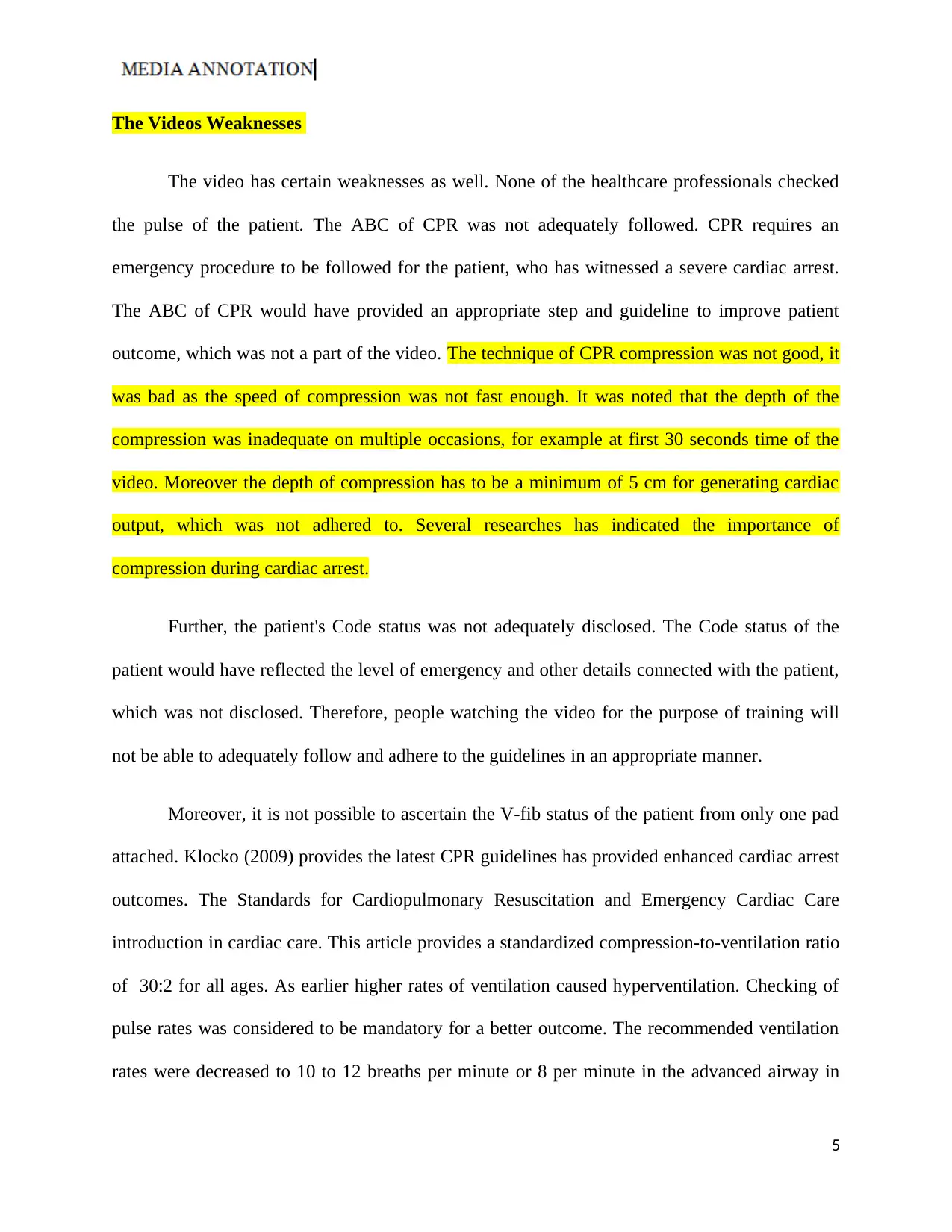
The Videos Weaknesses
The video has certain weaknesses as well. None of the healthcare professionals checked
the pulse of the patient. The ABC of CPR was not adequately followed. CPR requires an
emergency procedure to be followed for the patient, who has witnessed a severe cardiac arrest.
The ABC of CPR would have provided an appropriate step and guideline to improve patient
outcome, which was not a part of the video. The technique of CPR compression was not good, it
was bad as the speed of compression was not fast enough. It was noted that the depth of the
compression was inadequate on multiple occasions, for example at first 30 seconds time of the
video. Moreover the depth of compression has to be a minimum of 5 cm for generating cardiac
output, which was not adhered to. Several researches has indicated the importance of
compression during cardiac arrest.
Further, the patient's Code status was not adequately disclosed. The Code status of the
patient would have reflected the level of emergency and other details connected with the patient,
which was not disclosed. Therefore, people watching the video for the purpose of training will
not be able to adequately follow and adhere to the guidelines in an appropriate manner.
Moreover, it is not possible to ascertain the V-fib status of the patient from only one pad
attached. Klocko (2009) provides the latest CPR guidelines has provided enhanced cardiac arrest
outcomes. The Standards for Cardiopulmonary Resuscitation and Emergency Cardiac Care
introduction in cardiac care. This article provides a standardized compression-to-ventilation ratio
of 30:2 for all ages. As earlier higher rates of ventilation caused hyperventilation. Checking of
pulse rates was considered to be mandatory for a better outcome. The recommended ventilation
rates were decreased to 10 to 12 breaths per minute or 8 per minute in the advanced airway in
5
The video has certain weaknesses as well. None of the healthcare professionals checked
the pulse of the patient. The ABC of CPR was not adequately followed. CPR requires an
emergency procedure to be followed for the patient, who has witnessed a severe cardiac arrest.
The ABC of CPR would have provided an appropriate step and guideline to improve patient
outcome, which was not a part of the video. The technique of CPR compression was not good, it
was bad as the speed of compression was not fast enough. It was noted that the depth of the
compression was inadequate on multiple occasions, for example at first 30 seconds time of the
video. Moreover the depth of compression has to be a minimum of 5 cm for generating cardiac
output, which was not adhered to. Several researches has indicated the importance of
compression during cardiac arrest.
Further, the patient's Code status was not adequately disclosed. The Code status of the
patient would have reflected the level of emergency and other details connected with the patient,
which was not disclosed. Therefore, people watching the video for the purpose of training will
not be able to adequately follow and adhere to the guidelines in an appropriate manner.
Moreover, it is not possible to ascertain the V-fib status of the patient from only one pad
attached. Klocko (2009) provides the latest CPR guidelines has provided enhanced cardiac arrest
outcomes. The Standards for Cardiopulmonary Resuscitation and Emergency Cardiac Care
introduction in cardiac care. This article provides a standardized compression-to-ventilation ratio
of 30:2 for all ages. As earlier higher rates of ventilation caused hyperventilation. Checking of
pulse rates was considered to be mandatory for a better outcome. The recommended ventilation
rates were decreased to 10 to 12 breaths per minute or 8 per minute in the advanced airway in
5
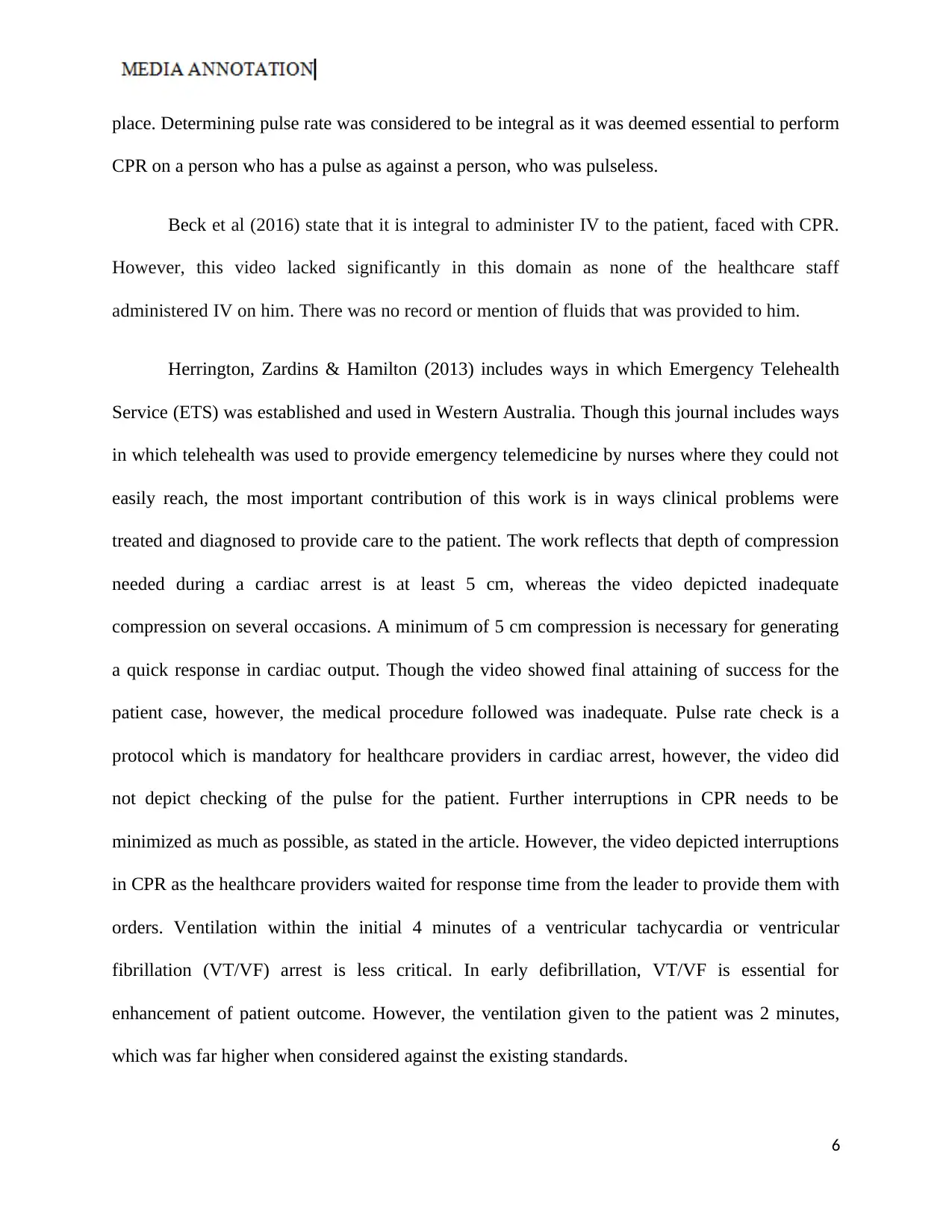
place. Determining pulse rate was considered to be integral as it was deemed essential to perform
CPR on a person who has a pulse as against a person, who was pulseless.
Beck et al (2016) state that it is integral to administer IV to the patient, faced with CPR.
However, this video lacked significantly in this domain as none of the healthcare staff
administered IV on him. There was no record or mention of fluids that was provided to him.
Herrington, Zardins & Hamilton (2013) includes ways in which Emergency Telehealth
Service (ETS) was established and used in Western Australia. Though this journal includes ways
in which telehealth was used to provide emergency telemedicine by nurses where they could not
easily reach, the most important contribution of this work is in ways clinical problems were
treated and diagnosed to provide care to the patient. The work reflects that depth of compression
needed during a cardiac arrest is at least 5 cm, whereas the video depicted inadequate
compression on several occasions. A minimum of 5 cm compression is necessary for generating
a quick response in cardiac output. Though the video showed final attaining of success for the
patient case, however, the medical procedure followed was inadequate. Pulse rate check is a
protocol which is mandatory for healthcare providers in cardiac arrest, however, the video did
not depict checking of the pulse for the patient. Further interruptions in CPR needs to be
minimized as much as possible, as stated in the article. However, the video depicted interruptions
in CPR as the healthcare providers waited for response time from the leader to provide them with
orders. Ventilation within the initial 4 minutes of a ventricular tachycardia or ventricular
fibrillation (VT/VF) arrest is less critical. In early defibrillation, VT/VF is essential for
enhancement of patient outcome. However, the ventilation given to the patient was 2 minutes,
which was far higher when considered against the existing standards.
6
CPR on a person who has a pulse as against a person, who was pulseless.
Beck et al (2016) state that it is integral to administer IV to the patient, faced with CPR.
However, this video lacked significantly in this domain as none of the healthcare staff
administered IV on him. There was no record or mention of fluids that was provided to him.
Herrington, Zardins & Hamilton (2013) includes ways in which Emergency Telehealth
Service (ETS) was established and used in Western Australia. Though this journal includes ways
in which telehealth was used to provide emergency telemedicine by nurses where they could not
easily reach, the most important contribution of this work is in ways clinical problems were
treated and diagnosed to provide care to the patient. The work reflects that depth of compression
needed during a cardiac arrest is at least 5 cm, whereas the video depicted inadequate
compression on several occasions. A minimum of 5 cm compression is necessary for generating
a quick response in cardiac output. Though the video showed final attaining of success for the
patient case, however, the medical procedure followed was inadequate. Pulse rate check is a
protocol which is mandatory for healthcare providers in cardiac arrest, however, the video did
not depict checking of the pulse for the patient. Further interruptions in CPR needs to be
minimized as much as possible, as stated in the article. However, the video depicted interruptions
in CPR as the healthcare providers waited for response time from the leader to provide them with
orders. Ventilation within the initial 4 minutes of a ventricular tachycardia or ventricular
fibrillation (VT/VF) arrest is less critical. In early defibrillation, VT/VF is essential for
enhancement of patient outcome. However, the ventilation given to the patient was 2 minutes,
which was far higher when considered against the existing standards.
6
⊘ This is a preview!⊘
Do you want full access?
Subscribe today to unlock all pages.

Trusted by 1+ million students worldwide
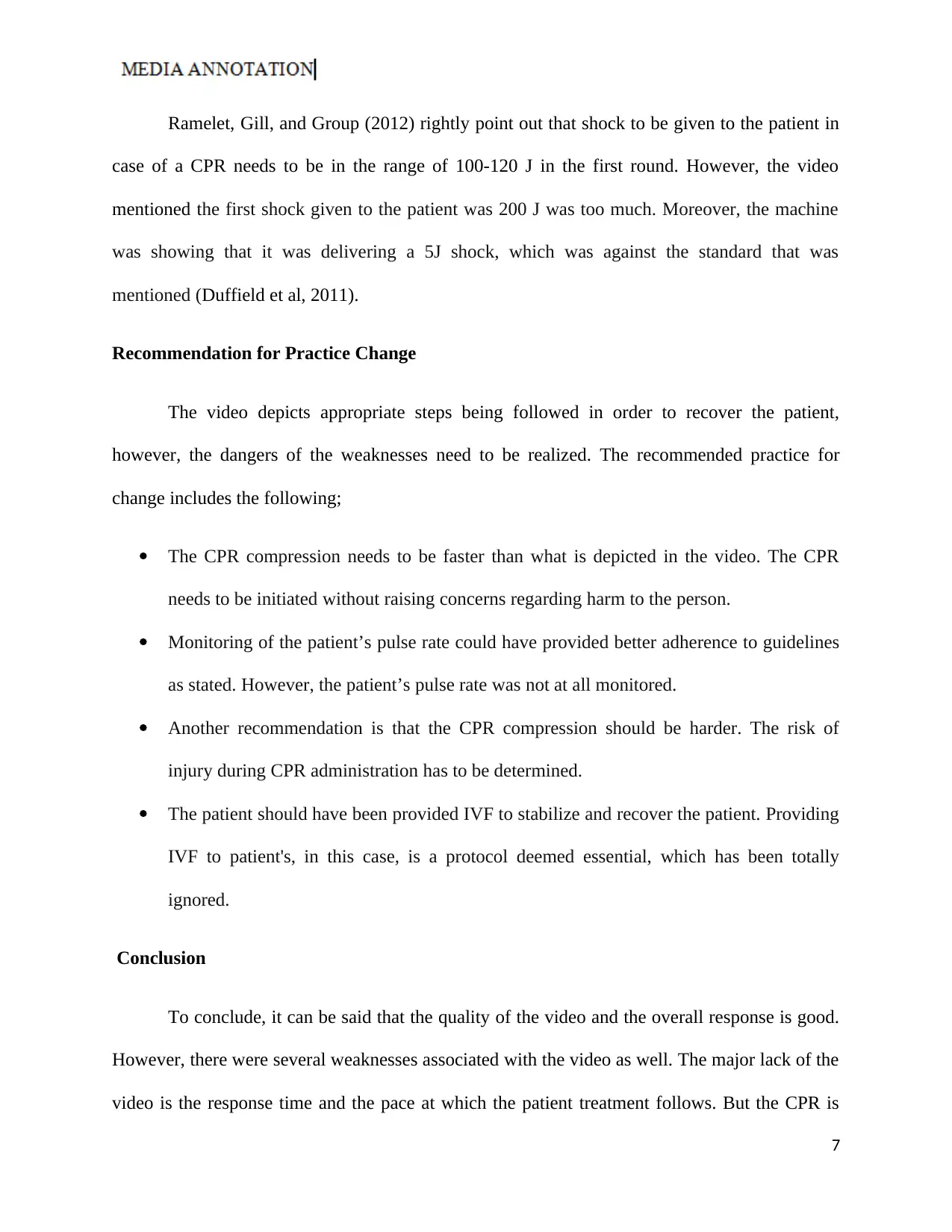
Ramelet, Gill, and Group (2012) rightly point out that shock to be given to the patient in
case of a CPR needs to be in the range of 100-120 J in the first round. However, the video
mentioned the first shock given to the patient was 200 J was too much. Moreover, the machine
was showing that it was delivering a 5J shock, which was against the standard that was
mentioned (Duffield et al, 2011).
Recommendation for Practice Change
The video depicts appropriate steps being followed in order to recover the patient,
however, the dangers of the weaknesses need to be realized. The recommended practice for
change includes the following;
The CPR compression needs to be faster than what is depicted in the video. The CPR
needs to be initiated without raising concerns regarding harm to the person.
Monitoring of the patient’s pulse rate could have provided better adherence to guidelines
as stated. However, the patient’s pulse rate was not at all monitored.
Another recommendation is that the CPR compression should be harder. The risk of
injury during CPR administration has to be determined.
The patient should have been provided IVF to stabilize and recover the patient. Providing
IVF to patient's, in this case, is a protocol deemed essential, which has been totally
ignored.
Conclusion
To conclude, it can be said that the quality of the video and the overall response is good.
However, there were several weaknesses associated with the video as well. The major lack of the
video is the response time and the pace at which the patient treatment follows. But the CPR is
7
case of a CPR needs to be in the range of 100-120 J in the first round. However, the video
mentioned the first shock given to the patient was 200 J was too much. Moreover, the machine
was showing that it was delivering a 5J shock, which was against the standard that was
mentioned (Duffield et al, 2011).
Recommendation for Practice Change
The video depicts appropriate steps being followed in order to recover the patient,
however, the dangers of the weaknesses need to be realized. The recommended practice for
change includes the following;
The CPR compression needs to be faster than what is depicted in the video. The CPR
needs to be initiated without raising concerns regarding harm to the person.
Monitoring of the patient’s pulse rate could have provided better adherence to guidelines
as stated. However, the patient’s pulse rate was not at all monitored.
Another recommendation is that the CPR compression should be harder. The risk of
injury during CPR administration has to be determined.
The patient should have been provided IVF to stabilize and recover the patient. Providing
IVF to patient's, in this case, is a protocol deemed essential, which has been totally
ignored.
Conclusion
To conclude, it can be said that the quality of the video and the overall response is good.
However, there were several weaknesses associated with the video as well. The major lack of the
video is the response time and the pace at which the patient treatment follows. But the CPR is
7
Paraphrase This Document
Need a fresh take? Get an instant paraphrase of this document with our AI Paraphraser
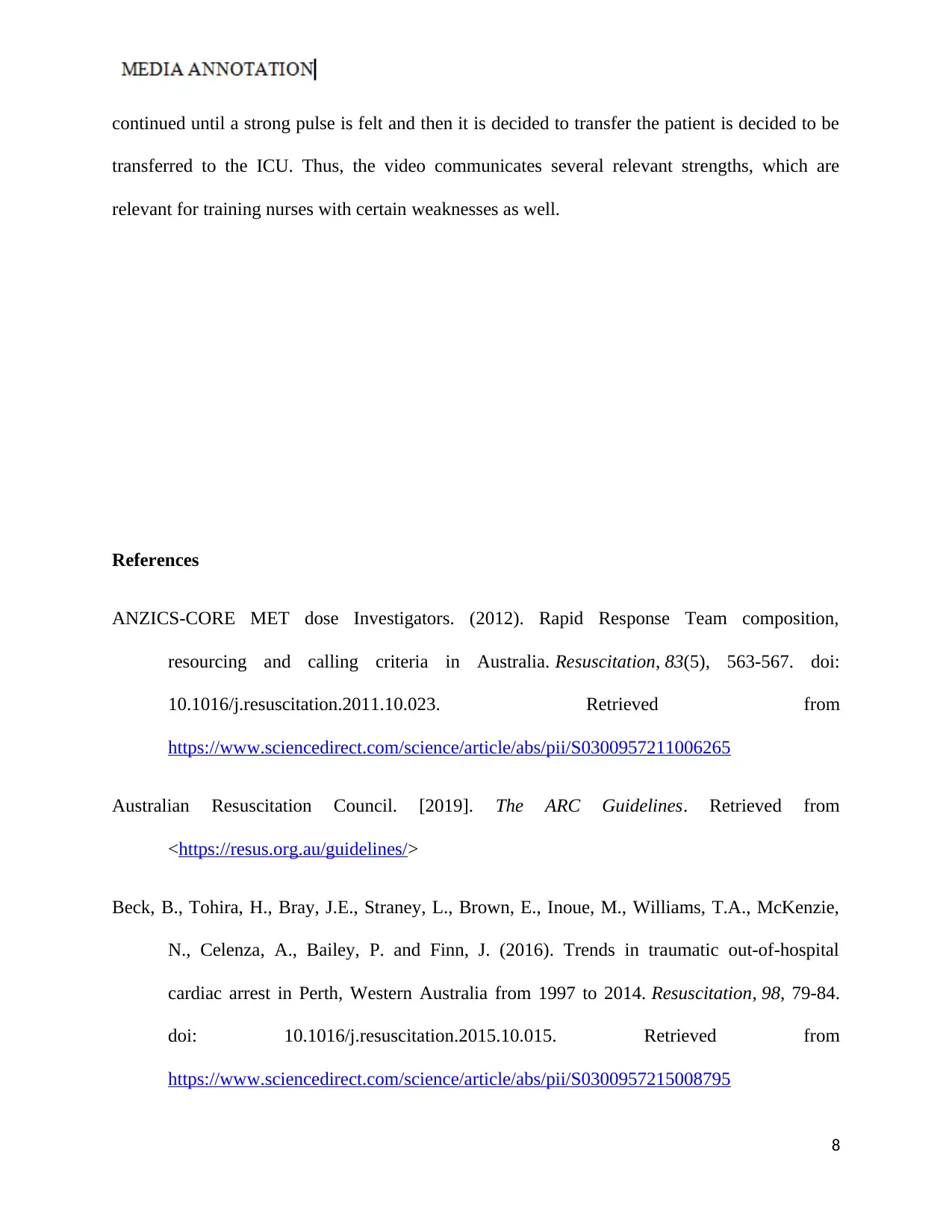
continued until a strong pulse is felt and then it is decided to transfer the patient is decided to be
transferred to the ICU. Thus, the video communicates several relevant strengths, which are
relevant for training nurses with certain weaknesses as well.
References
ANZICS-CORE MET dose Investigators. (2012). Rapid Response Team composition,
resourcing and calling criteria in Australia. Resuscitation, 83(5), 563-567. doi:
10.1016/j.resuscitation.2011.10.023. Retrieved from
https://www.sciencedirect.com/science/article/abs/pii/S0300957211006265
Australian Resuscitation Council. [2019]. The ARC Guidelines. Retrieved from
<https://resus.org.au/guidelines/>
Beck, B., Tohira, H., Bray, J.E., Straney, L., Brown, E., Inoue, M., Williams, T.A., McKenzie,
N., Celenza, A., Bailey, P. and Finn, J. (2016). Trends in traumatic out-of-hospital
cardiac arrest in Perth, Western Australia from 1997 to 2014. Resuscitation, 98, 79-84.
doi: 10.1016/j.resuscitation.2015.10.015. Retrieved from
https://www.sciencedirect.com/science/article/abs/pii/S0300957215008795
8
transferred to the ICU. Thus, the video communicates several relevant strengths, which are
relevant for training nurses with certain weaknesses as well.
References
ANZICS-CORE MET dose Investigators. (2012). Rapid Response Team composition,
resourcing and calling criteria in Australia. Resuscitation, 83(5), 563-567. doi:
10.1016/j.resuscitation.2011.10.023. Retrieved from
https://www.sciencedirect.com/science/article/abs/pii/S0300957211006265
Australian Resuscitation Council. [2019]. The ARC Guidelines. Retrieved from
<https://resus.org.au/guidelines/>
Beck, B., Tohira, H., Bray, J.E., Straney, L., Brown, E., Inoue, M., Williams, T.A., McKenzie,
N., Celenza, A., Bailey, P. and Finn, J. (2016). Trends in traumatic out-of-hospital
cardiac arrest in Perth, Western Australia from 1997 to 2014. Resuscitation, 98, 79-84.
doi: 10.1016/j.resuscitation.2015.10.015. Retrieved from
https://www.sciencedirect.com/science/article/abs/pii/S0300957215008795
8
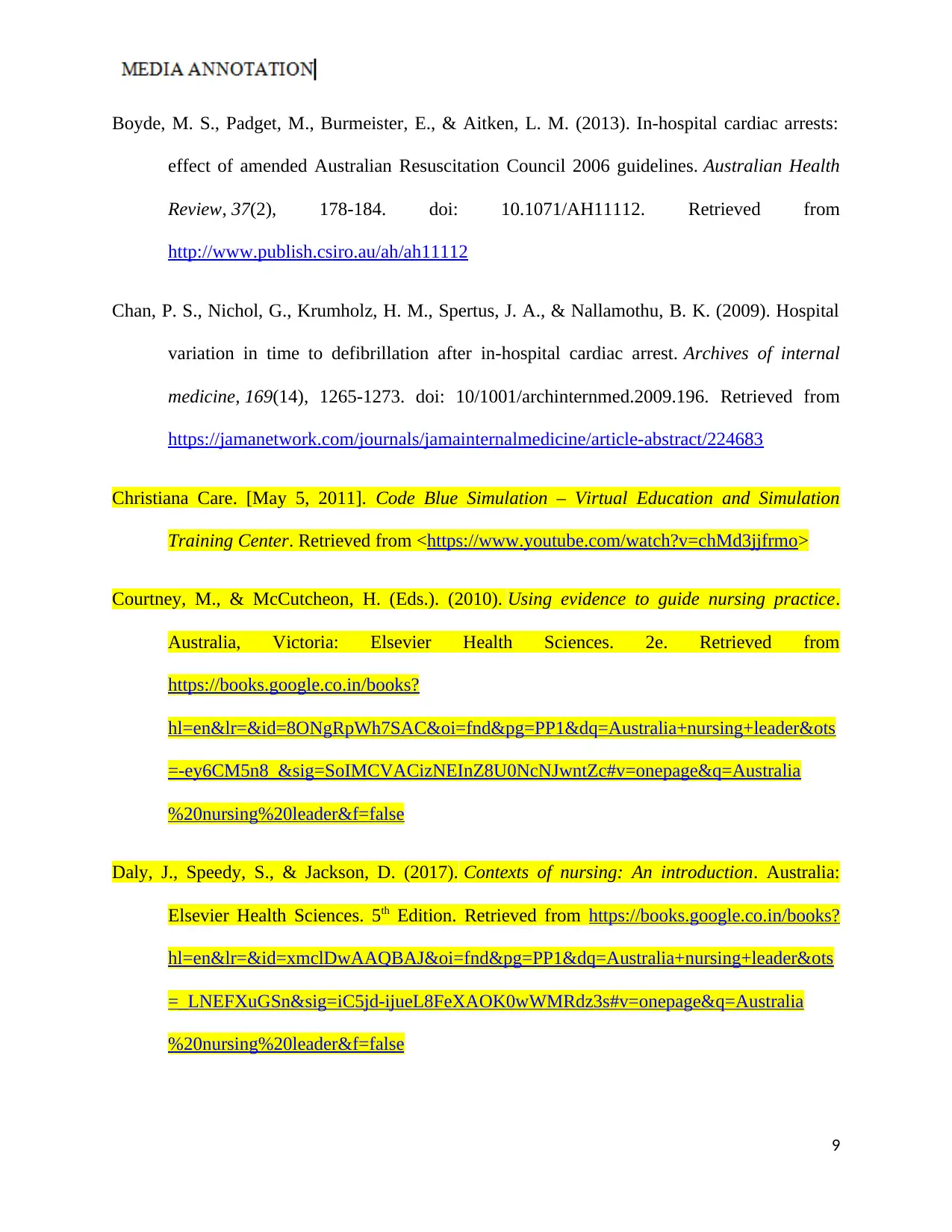
Boyde, M. S., Padget, M., Burmeister, E., & Aitken, L. M. (2013). In-hospital cardiac arrests:
effect of amended Australian Resuscitation Council 2006 guidelines. Australian Health
Review, 37(2), 178-184. doi: 10.1071/AH11112. Retrieved from
http://www.publish.csiro.au/ah/ah11112
Chan, P. S., Nichol, G., Krumholz, H. M., Spertus, J. A., & Nallamothu, B. K. (2009). Hospital
variation in time to defibrillation after in-hospital cardiac arrest. Archives of internal
medicine, 169(14), 1265-1273. doi: 10/1001/archinternmed.2009.196. Retrieved from
https://jamanetwork.com/journals/jamainternalmedicine/article-abstract/224683
Christiana Care. [May 5, 2011]. Code Blue Simulation – Virtual Education and Simulation
Training Center. Retrieved from <https://www.youtube.com/watch?v=chMd3jjfrmo>
Courtney, M., & McCutcheon, H. (Eds.). (2010). Using evidence to guide nursing practice.
Australia, Victoria: Elsevier Health Sciences. 2e. Retrieved from
https://books.google.co.in/books?
hl=en&lr=&id=8ONgRpWh7SAC&oi=fnd&pg=PP1&dq=Australia+nursing+leader&ots
=-ey6CM5n8_&sig=SoIMCVACizNEInZ8U0NcNJwntZc#v=onepage&q=Australia
%20nursing%20leader&f=false
Daly, J., Speedy, S., & Jackson, D. (2017). Contexts of nursing: An introduction. Australia:
Elsevier Health Sciences. 5th Edition. Retrieved from https://books.google.co.in/books?
hl=en&lr=&id=xmclDwAAQBAJ&oi=fnd&pg=PP1&dq=Australia+nursing+leader&ots
=_LNEFXuGSn&sig=iC5jd-ijueL8FeXAOK0wWMRdz3s#v=onepage&q=Australia
%20nursing%20leader&f=false
9
effect of amended Australian Resuscitation Council 2006 guidelines. Australian Health
Review, 37(2), 178-184. doi: 10.1071/AH11112. Retrieved from
http://www.publish.csiro.au/ah/ah11112
Chan, P. S., Nichol, G., Krumholz, H. M., Spertus, J. A., & Nallamothu, B. K. (2009). Hospital
variation in time to defibrillation after in-hospital cardiac arrest. Archives of internal
medicine, 169(14), 1265-1273. doi: 10/1001/archinternmed.2009.196. Retrieved from
https://jamanetwork.com/journals/jamainternalmedicine/article-abstract/224683
Christiana Care. [May 5, 2011]. Code Blue Simulation – Virtual Education and Simulation
Training Center. Retrieved from <https://www.youtube.com/watch?v=chMd3jjfrmo>
Courtney, M., & McCutcheon, H. (Eds.). (2010). Using evidence to guide nursing practice.
Australia, Victoria: Elsevier Health Sciences. 2e. Retrieved from
https://books.google.co.in/books?
hl=en&lr=&id=8ONgRpWh7SAC&oi=fnd&pg=PP1&dq=Australia+nursing+leader&ots
=-ey6CM5n8_&sig=SoIMCVACizNEInZ8U0NcNJwntZc#v=onepage&q=Australia
%20nursing%20leader&f=false
Daly, J., Speedy, S., & Jackson, D. (2017). Contexts of nursing: An introduction. Australia:
Elsevier Health Sciences. 5th Edition. Retrieved from https://books.google.co.in/books?
hl=en&lr=&id=xmclDwAAQBAJ&oi=fnd&pg=PP1&dq=Australia+nursing+leader&ots
=_LNEFXuGSn&sig=iC5jd-ijueL8FeXAOK0wWMRdz3s#v=onepage&q=Australia
%20nursing%20leader&f=false
9
⊘ This is a preview!⊘
Do you want full access?
Subscribe today to unlock all pages.

Trusted by 1+ million students worldwide
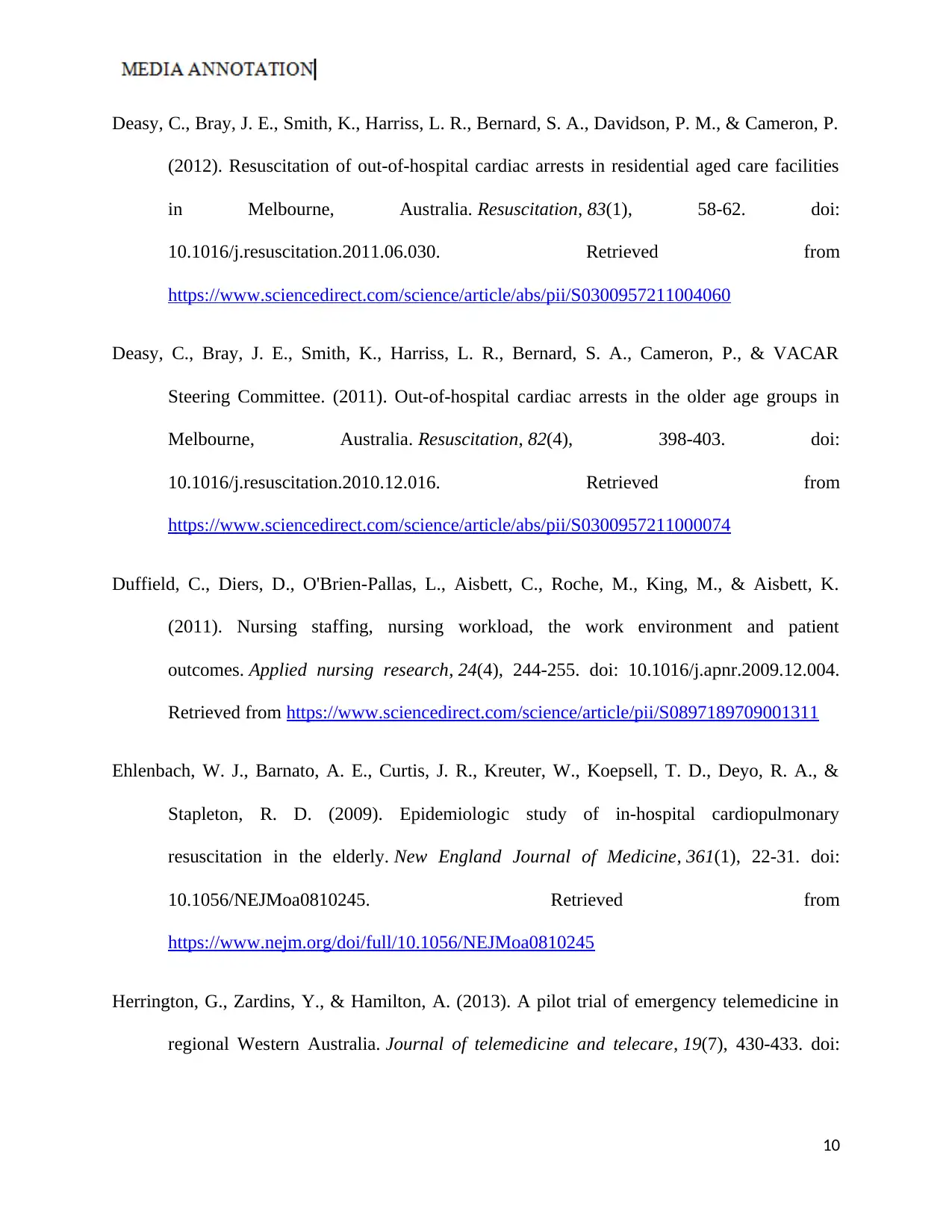
Deasy, C., Bray, J. E., Smith, K., Harriss, L. R., Bernard, S. A., Davidson, P. M., & Cameron, P.
(2012). Resuscitation of out-of-hospital cardiac arrests in residential aged care facilities
in Melbourne, Australia. Resuscitation, 83(1), 58-62. doi:
10.1016/j.resuscitation.2011.06.030. Retrieved from
https://www.sciencedirect.com/science/article/abs/pii/S0300957211004060
Deasy, C., Bray, J. E., Smith, K., Harriss, L. R., Bernard, S. A., Cameron, P., & VACAR
Steering Committee. (2011). Out-of-hospital cardiac arrests in the older age groups in
Melbourne, Australia. Resuscitation, 82(4), 398-403. doi:
10.1016/j.resuscitation.2010.12.016. Retrieved from
https://www.sciencedirect.com/science/article/abs/pii/S0300957211000074
Duffield, C., Diers, D., O'Brien-Pallas, L., Aisbett, C., Roche, M., King, M., & Aisbett, K.
(2011). Nursing staffing, nursing workload, the work environment and patient
outcomes. Applied nursing research, 24(4), 244-255. doi: 10.1016/j.apnr.2009.12.004.
Retrieved from https://www.sciencedirect.com/science/article/pii/S0897189709001311
Ehlenbach, W. J., Barnato, A. E., Curtis, J. R., Kreuter, W., Koepsell, T. D., Deyo, R. A., &
Stapleton, R. D. (2009). Epidemiologic study of in-hospital cardiopulmonary
resuscitation in the elderly. New England Journal of Medicine, 361(1), 22-31. doi:
10.1056/NEJMoa0810245. Retrieved from
https://www.nejm.org/doi/full/10.1056/NEJMoa0810245
Herrington, G., Zardins, Y., & Hamilton, A. (2013). A pilot trial of emergency telemedicine in
regional Western Australia. Journal of telemedicine and telecare, 19(7), 430-433. doi:
10
(2012). Resuscitation of out-of-hospital cardiac arrests in residential aged care facilities
in Melbourne, Australia. Resuscitation, 83(1), 58-62. doi:
10.1016/j.resuscitation.2011.06.030. Retrieved from
https://www.sciencedirect.com/science/article/abs/pii/S0300957211004060
Deasy, C., Bray, J. E., Smith, K., Harriss, L. R., Bernard, S. A., Cameron, P., & VACAR
Steering Committee. (2011). Out-of-hospital cardiac arrests in the older age groups in
Melbourne, Australia. Resuscitation, 82(4), 398-403. doi:
10.1016/j.resuscitation.2010.12.016. Retrieved from
https://www.sciencedirect.com/science/article/abs/pii/S0300957211000074
Duffield, C., Diers, D., O'Brien-Pallas, L., Aisbett, C., Roche, M., King, M., & Aisbett, K.
(2011). Nursing staffing, nursing workload, the work environment and patient
outcomes. Applied nursing research, 24(4), 244-255. doi: 10.1016/j.apnr.2009.12.004.
Retrieved from https://www.sciencedirect.com/science/article/pii/S0897189709001311
Ehlenbach, W. J., Barnato, A. E., Curtis, J. R., Kreuter, W., Koepsell, T. D., Deyo, R. A., &
Stapleton, R. D. (2009). Epidemiologic study of in-hospital cardiopulmonary
resuscitation in the elderly. New England Journal of Medicine, 361(1), 22-31. doi:
10.1056/NEJMoa0810245. Retrieved from
https://www.nejm.org/doi/full/10.1056/NEJMoa0810245
Herrington, G., Zardins, Y., & Hamilton, A. (2013). A pilot trial of emergency telemedicine in
regional Western Australia. Journal of telemedicine and telecare, 19(7), 430-433. doi:
10
Paraphrase This Document
Need a fresh take? Get an instant paraphrase of this document with our AI Paraphraser
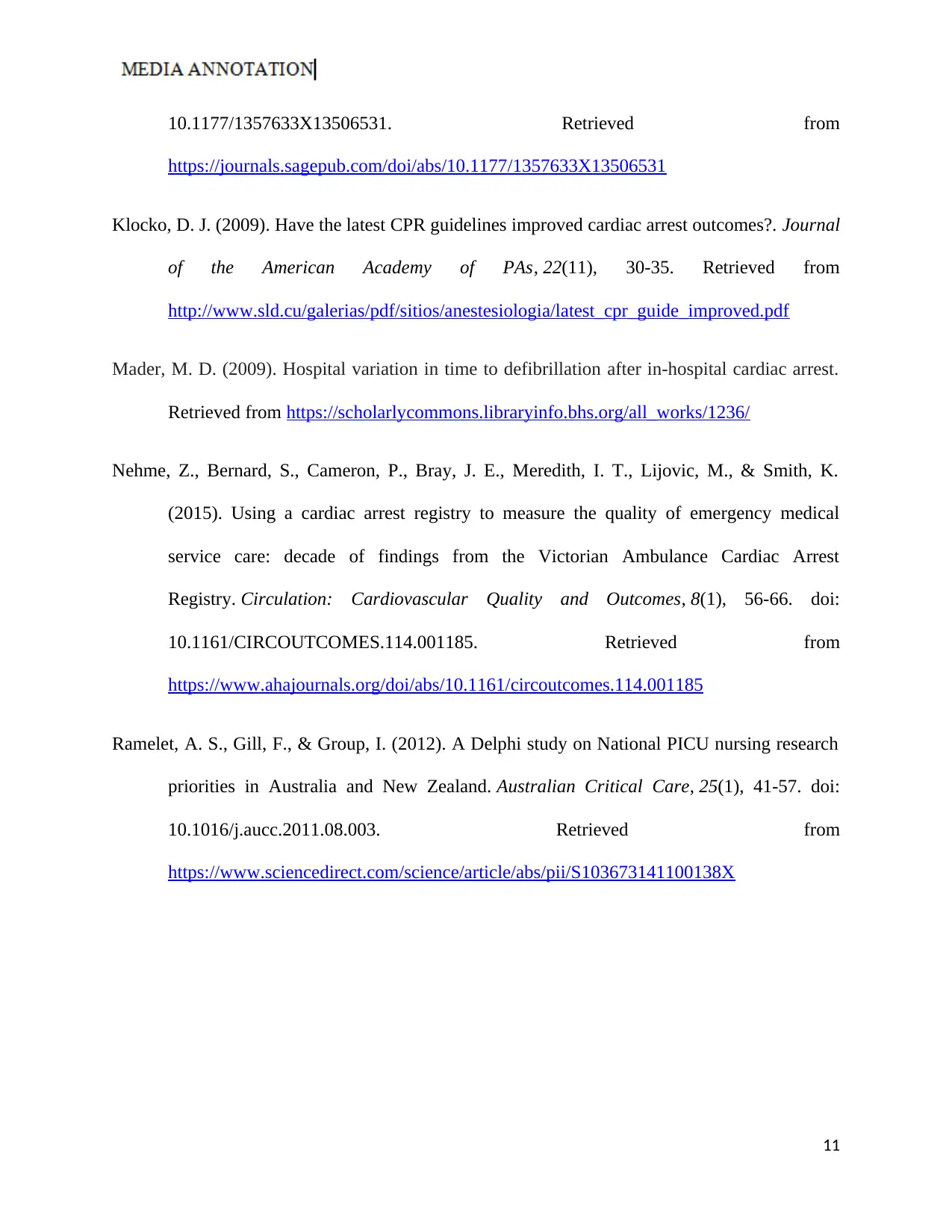
10.1177/1357633X13506531. Retrieved from
https://journals.sagepub.com/doi/abs/10.1177/1357633X13506531
Klocko, D. J. (2009). Have the latest CPR guidelines improved cardiac arrest outcomes?. Journal
of the American Academy of PAs, 22(11), 30-35. Retrieved from
http://www.sld.cu/galerias/pdf/sitios/anestesiologia/latest_cpr_guide_improved.pdf
Mader, M. D. (2009). Hospital variation in time to defibrillation after in-hospital cardiac arrest.
Retrieved from https://scholarlycommons.libraryinfo.bhs.org/all_works/1236/
Nehme, Z., Bernard, S., Cameron, P., Bray, J. E., Meredith, I. T., Lijovic, M., & Smith, K.
(2015). Using a cardiac arrest registry to measure the quality of emergency medical
service care: decade of findings from the Victorian Ambulance Cardiac Arrest
Registry. Circulation: Cardiovascular Quality and Outcomes, 8(1), 56-66. doi:
10.1161/CIRCOUTCOMES.114.001185. Retrieved from
https://www.ahajournals.org/doi/abs/10.1161/circoutcomes.114.001185
Ramelet, A. S., Gill, F., & Group, I. (2012). A Delphi study on National PICU nursing research
priorities in Australia and New Zealand. Australian Critical Care, 25(1), 41-57. doi:
10.1016/j.aucc.2011.08.003. Retrieved from
https://www.sciencedirect.com/science/article/abs/pii/S103673141100138X
11
https://journals.sagepub.com/doi/abs/10.1177/1357633X13506531
Klocko, D. J. (2009). Have the latest CPR guidelines improved cardiac arrest outcomes?. Journal
of the American Academy of PAs, 22(11), 30-35. Retrieved from
http://www.sld.cu/galerias/pdf/sitios/anestesiologia/latest_cpr_guide_improved.pdf
Mader, M. D. (2009). Hospital variation in time to defibrillation after in-hospital cardiac arrest.
Retrieved from https://scholarlycommons.libraryinfo.bhs.org/all_works/1236/
Nehme, Z., Bernard, S., Cameron, P., Bray, J. E., Meredith, I. T., Lijovic, M., & Smith, K.
(2015). Using a cardiac arrest registry to measure the quality of emergency medical
service care: decade of findings from the Victorian Ambulance Cardiac Arrest
Registry. Circulation: Cardiovascular Quality and Outcomes, 8(1), 56-66. doi:
10.1161/CIRCOUTCOMES.114.001185. Retrieved from
https://www.ahajournals.org/doi/abs/10.1161/circoutcomes.114.001185
Ramelet, A. S., Gill, F., & Group, I. (2012). A Delphi study on National PICU nursing research
priorities in Australia and New Zealand. Australian Critical Care, 25(1), 41-57. doi:
10.1016/j.aucc.2011.08.003. Retrieved from
https://www.sciencedirect.com/science/article/abs/pii/S103673141100138X
11
1 out of 11
Related Documents
Your All-in-One AI-Powered Toolkit for Academic Success.
+13062052269
info@desklib.com
Available 24*7 on WhatsApp / Email
![[object Object]](/_next/static/media/star-bottom.7253800d.svg)
Unlock your academic potential
Copyright © 2020–2025 A2Z Services. All Rights Reserved. Developed and managed by ZUCOL.





